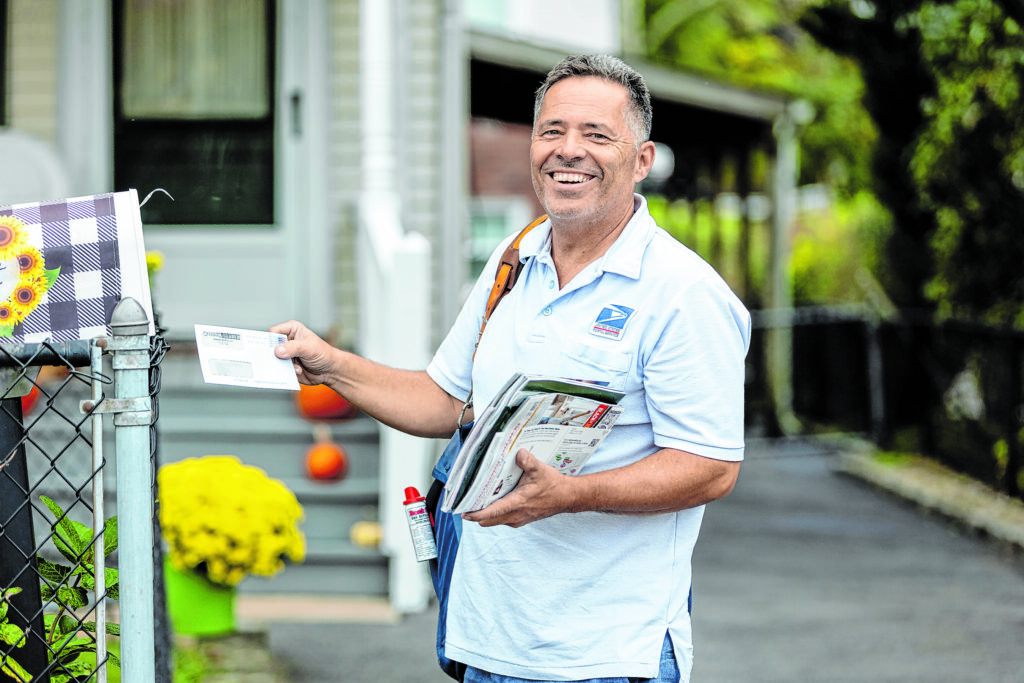
The history of the mailman can be traced back to ancient civilizations, such as Egypt and Persia, where dedicated messengers were employed to carry messages and documents.
In the United States, the role of the mailman began to take shape in the late 18th century with the establishment of the U.S. Postal Service. The first official mail carriers were appointed in major cities, responsible for delivering letters and parcels on foot or horseback.
With the advent of railways and the growth of the postal system, mail carriers evolved to serve rural and urban areas.
Today, mail carriers, often called postal workers, use vehicles to deliver mail and packages to homes and businesses, playing a crucial role in communication and commerce.
We had a chance to speak with one of our local Oyster Bay letter carriers.
Meet Jeff White.
“I have been in this community for 36 years,” White said. “I started in Oyster Bay.”
White said it was probably luck that he got assigned to such a great location.
“I love being a letter carrier because I get to be outside all day and my day belongs to me,” White said. “I used to have lunch every day with one of my elderly customers before she passed away.”
White has fond memories of his customers and the experiences along his route over the decades.
“Since I have been on the route so long, I have seen people grow up and move on,” White reminisced. “I see Billy Joel in the neighborhood sometimes; he owns a shop around the corner from the post office called 20th Century Cycles, a motorcycle gallery and shop.”

One of White’s most memorable, but unpleasant, memories on the job includes the notorious “dog attacks mailman” scenario.
“I got bit by a dog once when a customer tried to hand me an outgoing letter and I didn’t realize the dog was on a long leash,” White recalled. “The dog grabbed my leg.”
That was the first and only time in 36 years that White has been bitten by a dog.
“You never forget something like that.”
Despite being vigilant for dogs and other potential threats, White said the work day moves fast for him.
“I like the job,” White said. “It is, however, a physically demanding job.”
He decided to become a mailman nearly four decades ago after speaking to his own letter carrier about the career.
“He convinced me to take the job for its stability,” White said. “Before that I was helping my father with his business; my father was a hot rod photographer and craftsman.”
White said his father would write articles for Hot Rod Magazine and he was also the vice president of the local hot rod association.
“My father also loved working with wood, so he opened a local store with candy and crafts,” White said. “He built all the shelves and everything.”
White was born in Huntington. He has not drifted too far away.
“I’ve lived in Bethpage now for 30 years,” White said. “Even when I retire from the post office, I’ll come back to [visit] Oyster Bay; I love it here.”
White said he often comes to Oyster Bay with his wife for the summer concerts.
“We come every Friday [in the summer],” said White.
They love the Dancing In the Street series, put on by Oyster Bay Main Street Association for more than 12 years.
“I was also involved with the [Oyster Bay] community for years, through Boy Scouts,” White said. “Both of my boys are Eagle Scouts and I was a Scout Master for eight years.”
White remains involved with the Scouting organization to this day.
Oyster Bay is a hamlet on the North Shore of Long Island on the northeastern end of Nassau County. It is known for Sagamore Hill, the residence and summer White House of Theodore Roosevelt.
The Oyster Bay Post Office was built in 1936. New York architect William Bottomley designed the colonial revival structure to mirror the Oyster Bay Town Hall, located across the street. Inside the post office are murals by the prominent American artist, illustrator and author Ernest Peixotto, depicting scenes in Oyster Bay from 1653 to 1936. The Oyster Bay Post Office is listed on the National Register of Historic Places and featured on the Oyster Bay History Walk. It served 10 postal routes and has two rural routes.
Post Views: 54

